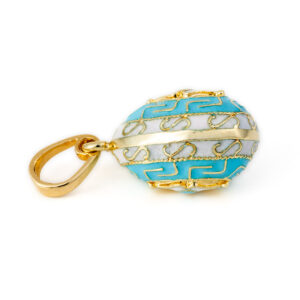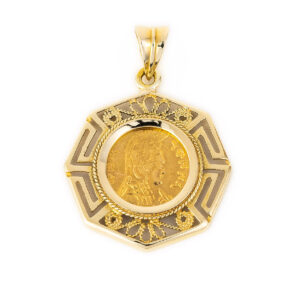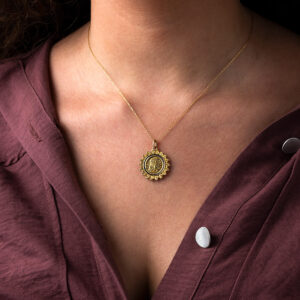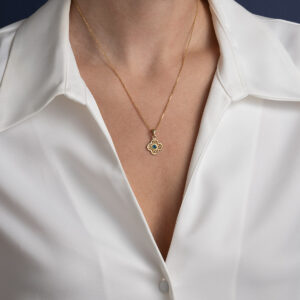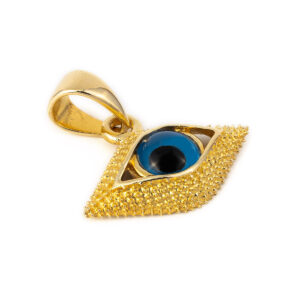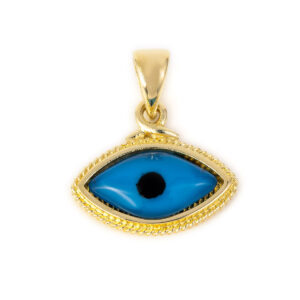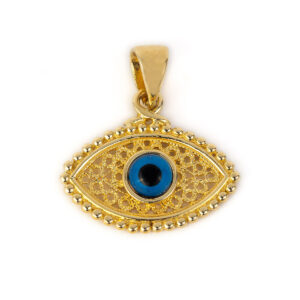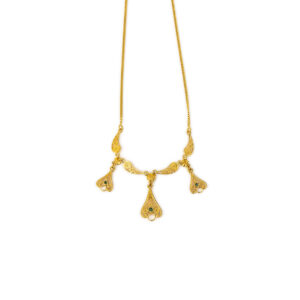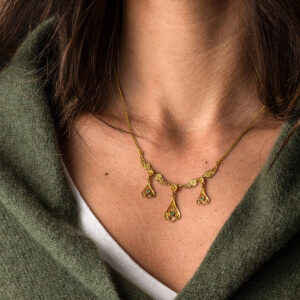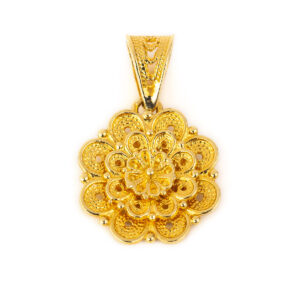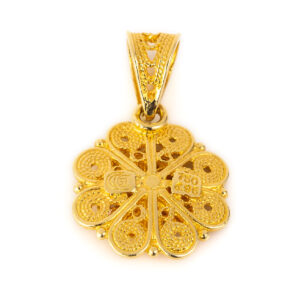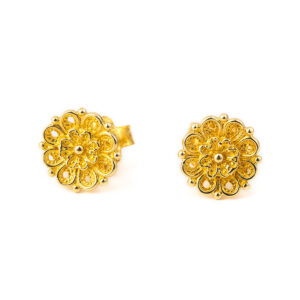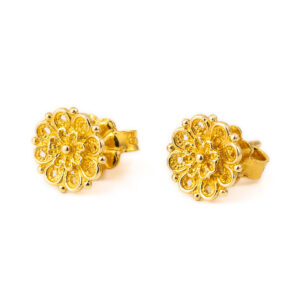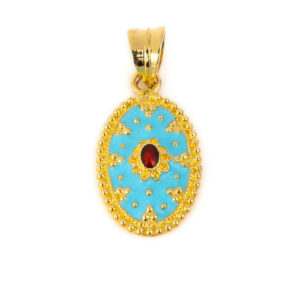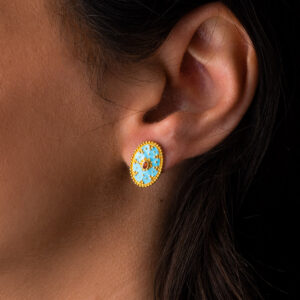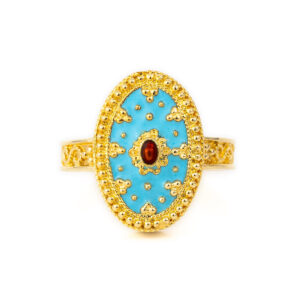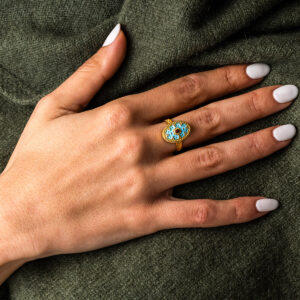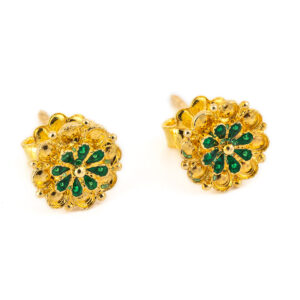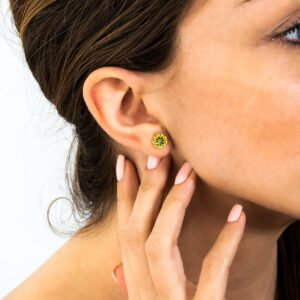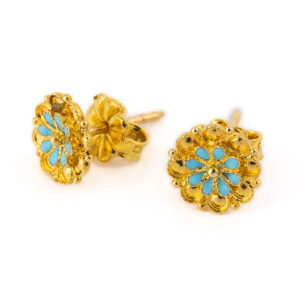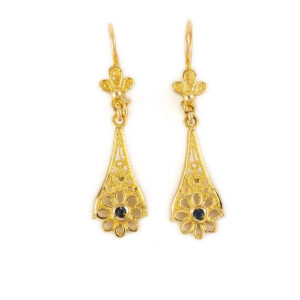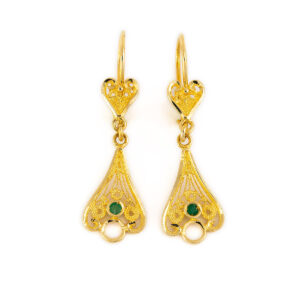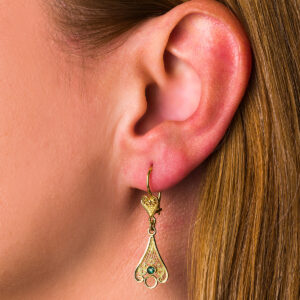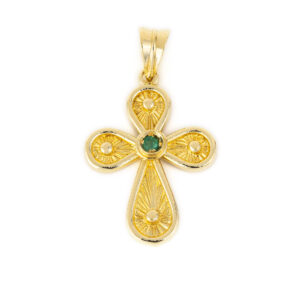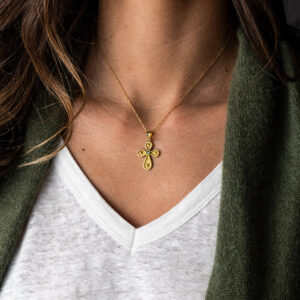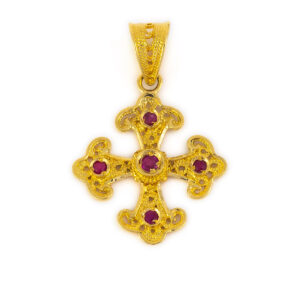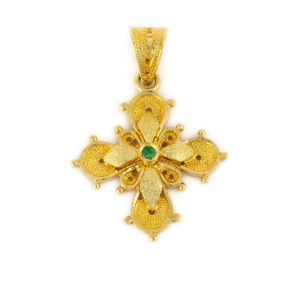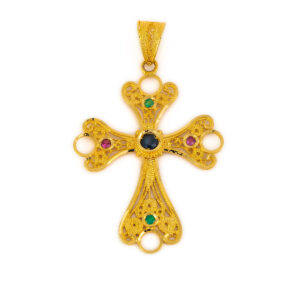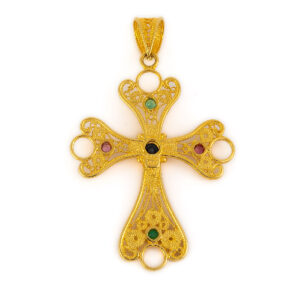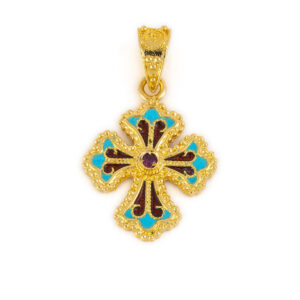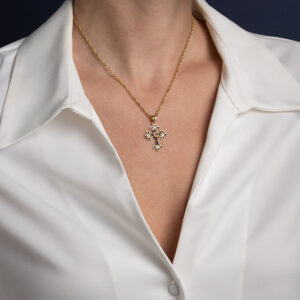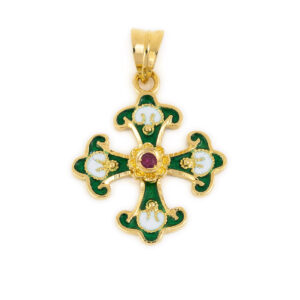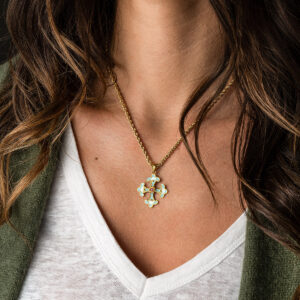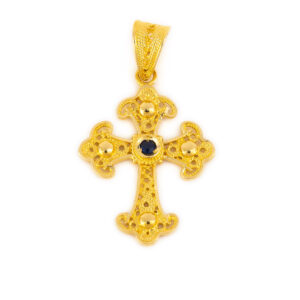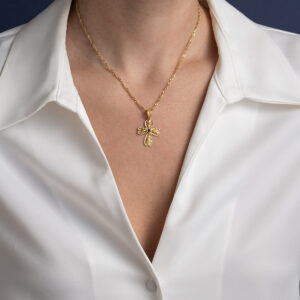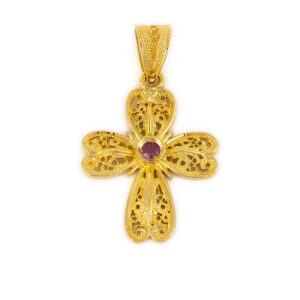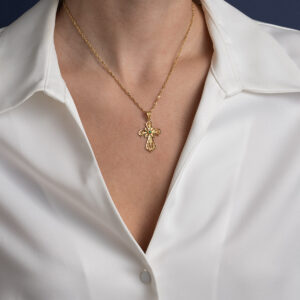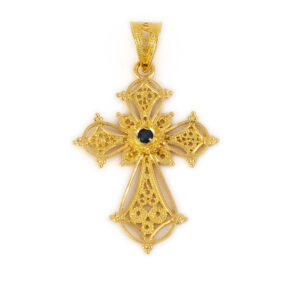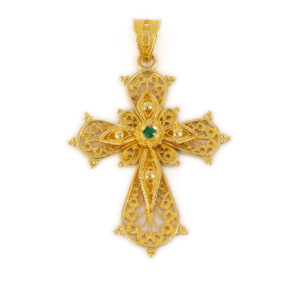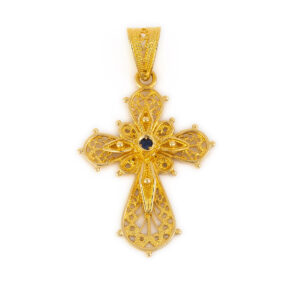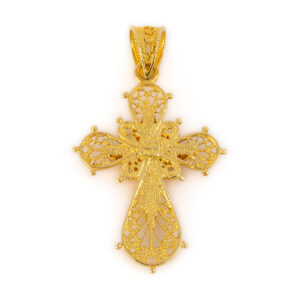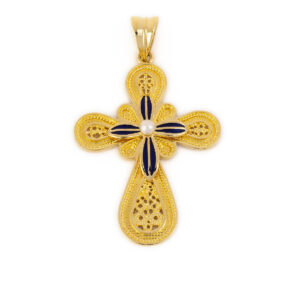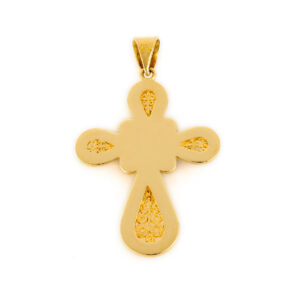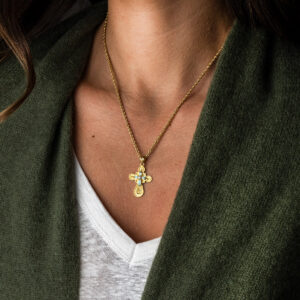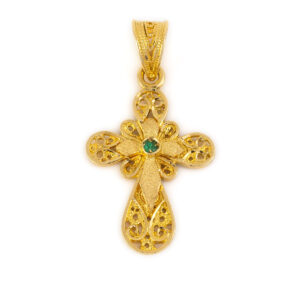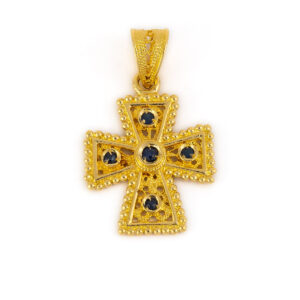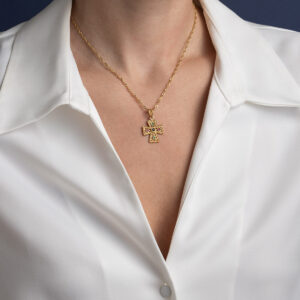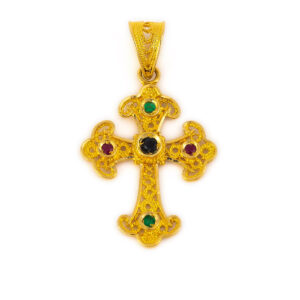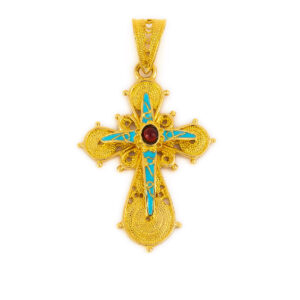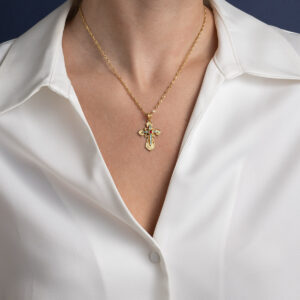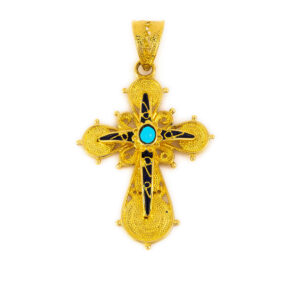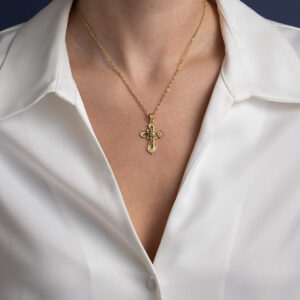Μενταγιόν Αυγό Μαίανδρος – Χρυσός 14Κ με Σμάλτο
645,00€Διαλέξτε ένα όμορφο δώρο εμπνευσμένο από τη μεγαλοπρεπή τέχνη της Fabergé!
Κατασκευασμένο από χρυσό 14 καρατίων και τυρκουάζ σμάλτο.
Διατίθεται με μπλε ή πράσινο ή κόκκινο σμάλτο
Το αυγό Fabergé είναι ένα αυγό κόσμημα που δημιουργήθηκε από τον οίκο Fabergé, στην Αγία Πετρούπολη της αυτοκρατορικής Ρωσίας. Σχεδόν όλα κατασκευάστηκαν υπό την επίβλεψη του Πέτερ Καρλ Φαμπερζέ μεταξύ 1885 και 1917,[παραπομπή απαιτείται] με πιο διάσημα τα 50 «αυτοκρατορικά» αυγά, 43 από τα οποία σώζονται, που κατασκευάστηκαν για τους Ρώσους τσάρους Αλέξανδρο Γ’ και Νικόλαο Β’ ως πασχαλινά δώρα για τις συζύγους και τις μητέρες τους. Το πρώτο αυγό Φαμπερζέ φιλοτεχνήθηκε για τον τσάρο Αλέξανδρο Γ΄, ο οποίος είχε αποφασίσει να χαρίσει στη σύζυγό του, την αυτοκράτειρα Μαρία Φεοντόροβνα, ένα πασχαλινό αυγό το 1885. Ο Peter Carl Fabergé ήταν ένας Ρώσος κοσμηματοπώλης, γνωστός κυρίως για τα περίφημα αυγά Fabergé που κατασκευάστηκαν στο στυλ των γνήσιων πασχαλινών αυγών, χρησιμοποιώντας πολύτιμα μέταλλα και πολύτιμους λίθους. Είναι ο ιδρυτής της διάσημης κληρονομιάς κοσμημάτων του οίκου Fabergé.
Το σχέδιο Μαίανδρος, ένα από τα πιο ιστορικά σύμβολα του ελληνικού κόσμου, ονομάζεται επίσης Ελληνικό Κλειδί και συμβολίζει τη μακροζωία και την αιωνιότητα. Το μοτίβο με τον Μέανδρο χρησιμοποιούνταν στην αρχαιότητα για τη διακόσμηση της ζωφόρου των ναών.
Όπως σε όλα τα χειροποίητα αντικείμενα μπορεί να υπάρχουν μικρές διαφορές στο βάρος και τις διαστάσεις και αυτό είναι που τα κάνει μοναδικά και πολύτιμα.
14K Χρυσό Μενταγιόν Θεά Αθηνά με Σμάλτο
578,00€Α beautiful and elegant Coin Pendant with Goddess Athena
The front side of this pendant is decorated with Goddess Athena and the back side is decorated with the wisdom owl
Made in 14k gold and blue enamel.
The chain shown is our 14K Gold Chain (not included).
Goddess Athena and Owl – Athenian silver tetradrachm
Dracma was the currency used in Greece during several periods in its history.
The tetradrachm was an Ancient Greek silver coin equivalent to fourdrachmae in Athens it replaced the earlier “heraldic” type of didrachms and it was in wide circulation from ca. 510 to ca. 38 BC.
This coin belongs to the so-called “new style Athenian coins” minted between 166 and 64 B.C. and is considered one of the most popular ancient Greek coins which illustrate the portrait of Goddess Athena on the one side and the wisdom owl on the other. Athena is an ancient Greek goddess associated with wisdom, handicraft, and warfare.
Athena was regarded as the patron and protectress of various cities across Greece, particularly the city of Athens, from which she most likely received her name. She’s usually shown in art wearing a helmet and holding a spear. Her major symbols include owls, olive trees, and snakes. Her temples were located atop the fortified Acropolis in the central part of the city. The Parthenon on the Athenian Acropolis is dedicated to her, along with numerous other temples and monuments. Her main festival in Athens was the Panathenaia, which was celebrated in midsummer and was the most important festival on the Athenian calendar.
In the classical Olympian pantheon, Athena was regarded as the favorite daughter of Zeus. The owl traditionally accompanies Athena. Because of such association, the owl has been used as a symbol of knowledge and wisdom. The inscriptions contain the city’s “national” appellation (“ΑΘΕ», i.e. “of the Athenians”).
As in all handmade items there may be small differences in weight and dimensions and this is what makes them unique and precious.
Μενταγιόν Θεά Αθηνά – Χρυσός 14Κ
765,00€Κατασκευασμένο από χρυσό 14 καρατίων.
Η αλυσίδα που απεικονίζεται είναι η Χρυσή Αλυσίδα Spiga 14Κ (δεν περιλαμβάνεται).
Όπως σε όλα τα χειροποίητα αντικείμενα μπορεί να υπάρχουν μικρές διαφορές στο βάρος και τις διαστάσεις και αυτό είναι που τα κάνει μοναδικά και πολύτιμα.
14K Χρυσό Μενταγιόν Νόμισμα Θεά Αθηνά
715,00€Η μπροστινή πλευρά αυτού του μενταγιόν είναι διακοσμημένη με τη θεά Αθηνά και η πίσω πλευρά είναι διακοσμημένη με την κουκουβάγια της σοφίας.
Κατασκευασμένο από χρυσό 14 καρατίων και μπλε σμάλτο.
Η αλυσίδα που απεικονίζεται είναι η 14Κ Χρυσή Αλυσίδα Cable (δεν περιλαμβάνονται).
Θεά Αθηνά και Κουκουβάγια – Αθηναϊκό αργυρό τετράδραχμο
Αυτό το νόμισμα ανήκει στα λεγόμενα «αθηναϊκά νομίσματα νέου στυλ» που κόπηκαν μεταξύ 166 και 64 π.Χ. και θεωρείται ένα από τα πιο δημοφιλή αρχαία ελληνικά νομίσματα που απεικονίζουν το πορτρέτο της Θεάς Αθηνάς. Η Αθηνά σχετίζεται με τη σοφία, τη χειροτεχνία και τον πόλεμο. Η Αθηνά θεωρούνταν προστάτιδα διαφόρων πόλεων σε όλη την Ελλάδα, αλλά ιδιαίτερα της Αθήνας, η οποία πήρε το όνομά της από εκείνη. Συνήθως εμφανίζεται στην τέχνη φορώντας κράνος και κρατώντας ένα δόρυ. Τα κύρια σύμβολά της περιλαμβάνουν κουκουβάγιες, ελιές και φίδια. Οι ναοί της βρίσκονταν στην οχυρωμένη Ακρόπολη στο κεντρικό τμήμα της πόλης. Ο Παρθενώνας στην Ακρόπολη της Αθήνας είναι αφιερωμένος σε αυτήν, μαζί με πολλούς άλλους ναούς και μνημεία. Το κύριο πανηγύρι της στην Αθήνα ήταν τα Παναθήναια, τα οποία γιορτάζονταν το καλοκαίρι και ήταν το σημαντικότερο πανηγύρι του αθηναϊκού ημερολογίου. Στο κλασικό Ολύμπιο πάνθεον, η Αθηνά θεωρούνταν η αγαπημένη κόρη του Δία. Η κουκουβάγια συνοδεύει παραδοσιακά την Αθηνά. Λόγω αυτής της συσχέτισης, η κουκουβάγια έχει χρησιμοποιηθεί ως σύμβολο γνώσης και σοφίας. Οι επιγραφές περιέχουν την «εθνική» ονομασία της πόλης («ΑΘΕ», δηλαδή «των Αθηναίων»).
Μενταγιόν Σταυρός Μάτι Filigree – Χρυσό 14Κ
255,00€Κατασκευασμένο από 14Κ χρυσό.
Το σύμβολο και η δεισιδαιμονία του κακού ματιού είναι μία από τις ισχυρότερες συμβολικές εικόνες στον κόσμο. Τα πρώτα γνωστά στοιχεία για την πίστη στο μάτι ανάγονται στην αρχαία Ελλάδα και τη Ρώμη. Υποτίθεται ότι προστατεύει όποιον το φοράει και διάφοροι πολιτισμοί πιστεύουν σε αυτό. Ωστόσο στην Ελλάδα είναι μπλε γιατί εκείνη την εποχή τα μπλε μάτια δεν ήταν τόσο συνηθισμένα και θεωρούνταν ότι έδιναν το “κακό μάτι”.
Χειροποίητο ελληνικό κόσμημα.
Μάτι Μενταγιόν – Χρυσό 14Κ
272,00€Κατασκευασμένο από 14Κ χρυσό.
Το σύμβολο και η δεισιδαιμονία του κακού ματιού είναι μία από τις ισχυρότερες συμβολικές εικόνες στον κόσμο. Τα πρώτα γνωστά στοιχεία για την πίστη στο μάτι ανάγονται στην αρχαία Ελλάδα και τη Ρώμη. Υποτίθεται ότι προστατεύει όποιον το φοράει και διάφοροι πολιτισμοί πιστεύουν σε αυτό. Ωστόσο στην Ελλάδα είναι μπλε γιατί εκείνη την εποχή τα μπλε μάτια δεν ήταν τόσο συνηθισμένα και θεωρούνταν ότι έδιναν το “κακό μάτι”.
Χειροποίητο ελληνικό κόσμημα.
Μάτι Filigree Μενταγιόν – Χρυσό 14Κ
340,00€Κατασκευασμένο από 14Κ χρυσό.
Το σύμβολο και η δεισιδαιμονία του κακού ματιού είναι μία από τις ισχυρότερες συμβολικές εικόνες στον κόσμο. Τα πρώτα γνωστά στοιχεία για την πίστη στο μάτι ανάγονται στην αρχαία Ελλάδα και τη Ρώμη. Υποτίθεται ότι προστατεύει όποιον το φοράει και διάφοροι πολιτισμοί πιστεύουν σε αυτό. Ωστόσο στην Ελλάδα είναι μπλε γιατί εκείνη την εποχή τα μπλε μάτια δεν ήταν τόσο συνηθισμένα και θεωρούνταν ότι έδιναν το “κακό μάτι”.
Χειροποίητο ελληνικό κόσμημα.
Μενταγιόν Φλοράλ Μάτι – Χρυσό 14Κ
220,00€ – 390,00€Κατασκευασμένο από 14Κ χρυσό.
Το σύμβολο και η δεισιδαιμονία του κακού ματιού είναι μία από τις ισχυρότερες συμβολικές εικόνες στον κόσμο. Τα πρώτα γνωστά στοιχεία για την πίστη στο μάτι ανάγονται στην αρχαία Ελλάδα και τη Ρώμη. Υποτίθεται ότι προστατεύει όποιον το φοράει και διάφοροι πολιτισμοί πιστεύουν σε αυτό. Ωστόσο στην Ελλάδα είναι μπλε γιατί εκείνη την εποχή τα μπλε μάτια δεν ήταν τόσο συνηθισμένα και θεωρούνταν ότι έδιναν το “κακό μάτι”.
Χειροποίητο ελληνικό κόσμημα.
Μενταγιόν Μάτι – Χρυσό 14Κ
204,00€ – 390,00€Κατασκευασμένο από 14Κ χρυσό.
Το σύμβολο και η δεισιδαιμονία του κακού ματιού είναι μία από τις ισχυρότερες συμβολικές εικόνες στον κόσμο. Τα πρώτα γνωστά στοιχεία για την πίστη στο μάτι ανάγονται στην αρχαία Ελλάδα και τη Ρώμη. Υποτίθεται ότι προστατεύει όποιον το φοράει και διάφοροι πολιτισμοί πιστεύουν σε αυτό. Ωστόσο στην Ελλάδα είναι μπλε γιατί εκείνη την εποχή τα μπλε μάτια δεν ήταν τόσο συνηθισμένα και θεωρούνταν ότι έδιναν το “κακό μάτι”.
Χειροποίητο ελληνικό κόσμημα.
Βυζαντινό Μενταγιόν Μάτι Filigree – Χρυσό 14Κ
220,00€ – 374,00€Κατασκευασμένο από 14Κ χρυσό.
Το σύμβολο και η δεισιδαιμονία του κακού ματιού είναι μία από τις ισχυρότερες συμβολικές εικόνες στον κόσμο. Τα πρώτα γνωστά στοιχεία για την πίστη στο μάτι ανάγονται στην αρχαία Ελλάδα και τη Ρώμη. Υποτίθεται ότι προστατεύει όποιον το φοράει και διάφοροι πολιτισμοί πιστεύουν σε αυτό. Ωστόσο στην Ελλάδα είναι μπλε γιατί εκείνη την εποχή τα μπλε μάτια δεν ήταν τόσο συνηθισμένα και θεωρούνταν ότι έδιναν το “κακό μάτι”.
Χειροποίητο ελληνικό κόσμημα.
18K Χρυσό Βυζαντινό Κολιέ Φιλιγκράν με Σμαράγδι
1.386,00€Βυζαντινό κολιέ διακοσμημένο με λεπτό φιλιγκράν, τρεις ροζέτες λουλουδιών και σμαράγδια.
Χειροποίητο ελληνικό κόσμημα με μεγάλη προσοχή στη λεπτομέρεια. Εμπνευσμένο από τη βυζαντινή τέχνη.
Κατασκευασμένο από χρυσό 18 καρατίων.
Το φιλιγκράν είναι ένα λεπτό είδος μεταλλικής κοσμηματοποιίας, κατασκευασμένο με μικροσκοπικές χάντρες ή στριφτά νήματα, ή και τα δύο σε συνδυασμό, συγκολλημένα μεταξύ τους ή στην επιφάνεια ενός αντικειμένου από το ίδιο μέταλλο και τοποθετημένα σε καλλιτεχνικά μοτίβα. Η τέχνη του φιλιγκράν χρονολογείται από την αρχαία ιστορία. Τα πρώτα από τα ευρεθέντα κοσμήματα με αυτή την τεχνική έχουν βρεθεί στη Μεσοποταμία και χρονολογούνται χιλιάδες χρόνια π.Χ. Στον αρχαίο κόσμο και ιδιαίτερα στη Μικρά Ασία, η τέχνη αυτή αναπτύχθηκε ήταν στο υψηλότερο επίπεδο.
Άνθος Ροζέτα
Η ροζέτα (τριαντάφυλλο) είναι ένα διαχρονικό κόσμημα, σύμβολο και φυλαχτό. Η προέλευση του όρου είναι η ελληνική λέξη για το τριαντάφυλλο – ρόδων (ρόδον). Η χρήση του ξεκίνησε στη μυκηναϊκή εποχή και συνεχίζεται μέχρι τη 2η χιλιετία π.Χ. Η μυκηναϊκή ρόδα είναι ένα μοτίβο που ήταν ευρέως διαδεδομένο σε όλη τη Μεσοποταμία, την Αίγυπτο, την Ελλάδα και άλλους αρχαίους πολιτισμούς. Είναι εμπνευσμένο από μια χάντρα με μυκηναϊκή ροζέτα, που βρέθηκε στις Μυκήνες και χρονολογείται στο 1400-1300 π.Χ. Η ροζέτα χρησιμοποιήθηκε εκτενώς στα αρχαία ελληνικά μυκηναϊκά κοσμήματα, στην αρχιτεκτονική, στην κεραμική και στα γλυπτά από το 1500 π.Χ. Οι μυκηναϊκοί ρόδακες είχαν συνήθως 6 ή 8 ή 12 φύλλα και δεκαέξι φύλλα κατά τη διάρκεια της Μακεδονικής Δυναστείας. Τέτοιες λεπτομέρειες όπως το σχήμα του ρόδακα και ο αριθμός των φύλλων τείνουν να ποικίλλουν ανάλογα με την εποχή ή τις δοξασίες. Οι ρόδακες χρησιμοποιούνταν για τη διακόσμηση των υφασμάτων, των ζωνών και των στεφάνων των βασιλέων. Ο αριθμός των φύλλων είχε συμβολικό χαρακτήρα κάθε φορά. Τα τέσσερα στοιχεία της φύσης (άνεμος, γη, φωτιά, νερό), τα επτά θαύματα του αρχαίου κόσμου ή οι δώδεκα θεοί των αρχαίων Ελλήνων και η παγκόσμια κυριαρχία και ακτινοβολία των βασιλιάδων της Μακεδονίας. Ήταν σημάδια ομορφιάς, αγνότητας, ευζωίας, λατρείας και εξουσίας. Η ροζέτα ή ρόδαξ ήταν ίσως το πιο δημοφιλές και αγαπημένο διακοσμητικό στοιχείο στη μυκηναϊκή εποχή, την κλασική αρχαιότητα και τους βυζαντινούς χρόνους.
18K Χρυσό Βυζαντινό Κολιέ Φιλιγκράν με Ζαφείρι
1.474,00€Βυζαντινό κολιέ διακοσμημένο με ένα λεπτό φιλιγκράν και τρεις ροζέτες λουλουδιών που είναι διακοσμημένες με ένα ζαφείρι.
Χειροποίητο ελληνικό κόσμημα με μεγάλη προσοχή στη λεπτομέρεια.
Εμπνευσμένο από τη βυζαντινή τέχνη.
Κατασκευασμένο από χρυσό 18 καρατίων.
Το φιλιγκράν είναι ένα λεπτό είδος μεταλλικής κοσμηματοποιίας, κατασκευασμένο με μικροσκοπικές χάντρες ή στριφτά νήματα, ή και τα δύο σε συνδυασμό, συγκολλημένα μεταξύ τους ή στην επιφάνεια ενός αντικειμένου από το ίδιο μέταλλο και τοποθετημένα σε καλλιτεχνικά μοτίβα. Η τέχνη του φιλιγκράν χρονολογείται από την αρχαία ιστορία. Τα πρώτα από τα ευρεθέντα κοσμήματα με αυτή την τεχνική έχουν βρεθεί στη Μεσοποταμία και χρονολογούνται χιλιάδες χρόνια π.Χ. Στον αρχαίο κόσμο και ιδιαίτερα στη Μικρά Ασία, η τέχνη αυτή αναπτύχθηκε ήταν στο υψηλότερο επίπεδο.t world and particularly in Asia Minor, this art grew were at the highest level.
Άνθος Ροζέτα
Η ροζέτα (τριαντάφυλλο) είναι ένα διαχρονικό κόσμημα, σύμβολο και φυλαχτό. Η προέλευση του όρου είναι η ελληνική λέξη για το τριαντάφυλλο – ρόδων (ρόδον). Η χρήση του ξεκίνησε στη μυκηναϊκή εποχή και συνεχίζεται μέχρι τη 2η χιλιετία π.Χ. Η μυκηναϊκή ρόδα είναι ένα μοτίβο που ήταν ευρέως διαδεδομένο σε όλη τη Μεσοποταμία, την Αίγυπτο, την Ελλάδα και άλλους αρχαίους πολιτισμούς. Είναι εμπνευσμένο από μια χάντρα με μυκηναϊκή ροζέτα, που βρέθηκε στις Μυκήνες και χρονολογείται στο 1400-1300 π.Χ. Η ροζέτα χρησιμοποιήθηκε εκτενώς στα αρχαία ελληνικά μυκηναϊκά κοσμήματα, στην αρχιτεκτονική, στην κεραμική και στα γλυπτά από το 1500 π.Χ. Οι μυκηναϊκοί ρόδακες είχαν συνήθως 6 ή 8 ή 12 φύλλα και δεκαέξι φύλλα κατά τη διάρκεια της Μακεδονικής Δυναστείας. Τέτοιες λεπτομέρειες όπως το σχήμα του ρόδακα και ο αριθμός των φύλλων τείνουν να ποικίλλουν ανάλογα με την εποχή ή τις δοξασίες. Οι ρόδακες χρησιμοποιούνταν για τη διακόσμηση των υφασμάτων, των ζωνών και των στεφάνων των βασιλέων. Ο αριθμός των φύλλων είχε συμβολικό χαρακτήρα κάθε φορά. Τα τέσσερα στοιχεία της φύσης (άνεμος, γη, φωτιά, νερό), τα επτά θαύματα του αρχαίου κόσμου ή οι δώδεκα θεοί των αρχαίων Ελλήνων και η παγκόσμια κυριαρχία και ακτινοβολία των βασιλιάδων της Μακεδονίας. Ήταν σημάδια ομορφιάς, αγνότητας, ευζωίας, λατρείας και εξουσίας. Η ροζέτα ή ρόδαξ ήταν ίσως το πιο δημοφιλές και αγαπημένο διακοσμητικό στοιχείο στη μυκηναϊκή εποχή, την κλασική αρχαιότητα και τους βυζαντινούς χρόνους.
18K Χρυσό Μενταγιόν Φιλιγκράν Βυζαντινής Ροζέτας
572,00€18K Χρυσό Μενταγιόν Φιλιγκράν Βυζαντινής Ροζέτας
Βυζαντινό κρεμαστό κόσμημα που έχει το σχήμα της ροζέτας λουλουδιών. Αυτό το κρεμαστό κόσμημα είναι διακοσμημένο με λεπτό φιλιγκράν και κόκκους πολύτιμου μετάλλου.
Χειροποίητο ελληνικό κόσμημα με μεγάλη προσοχή στη λεπτομέρεια.
Εμπνευσμένο από τη βυζαντινή τέχνη.
Κατασκευασμένο από χρυσό 18 καρατίων
Ανθος Ροζέτα
Η ροζέτα (τριαντάφυλλο) είναι ένα διαχρονικό κόσμημα, σύμβολο και φυλαχτό. Η προέλευση του όρου είναι η ελληνική λέξη για το τριαντάφυλλο – ρόδων (ρόδον). Η χρήση του ξεκίνησε στη μυκηναϊκή εποχή και συνεχίζεται μέχρι τη 2η χιλιετία π.Χ. Η μυκηναϊκή ρόδα είναι ένα μοτίβο που ήταν ευρέως διαδεδομένο σε όλη τη Μεσοποταμία, την Αίγυπτο, την Ελλάδα και άλλους αρχαίους πολιτισμούς. Είναι εμπνευσμένο από μια χάντρα με μυκηναϊκή ροζέτα, που βρέθηκε στις Μυκήνες και χρονολογείται στο 1400-1300 π.Χ. Η ροζέτα χρησιμοποιήθηκε εκτενώς στα αρχαία ελληνικά μυκηναϊκά κοσμήματα, στην αρχιτεκτονική, στην κεραμική και στα γλυπτά από το 1500 π.Χ. Οι μυκηναϊκοί ρόδακες είχαν συνήθως 6 ή 8 ή 12 φύλλα και δεκαέξι φύλλα κατά τη διάρκεια της Μακεδονικής Δυναστείας. Τέτοιες λεπτομέρειες όπως το σχήμα του ρόδακα και ο αριθμός των φύλλων τείνουν να ποικίλλουν ανάλογα με την εποχή ή τις δοξασίες. Οι ρόδακες χρησιμοποιούνταν για τη διακόσμηση των υφασμάτων, των ζωνών και των στεφάνων των βασιλέων. Ο αριθμός των φύλλων είχε συμβολικό χαρακτήρα κάθε φορά. Τα τέσσερα στοιχεία της φύσης (άνεμος, γη, φωτιά, νερό), τα επτά θαύματα του αρχαίου κόσμου ή οι δώδεκα θεοί των αρχαίων Ελλήνων και η παγκόσμια κυριαρχία και ακτινοβολία των βασιλιάδων της Μακεδονίας. Ήταν σημάδια ομορφιάς, αγνότητας, ευζωίας, λατρείας και εξουσίας. Η ροζέτα ή ρόδαξ ήταν ίσως το πιο δημοφιλές και αγαπημένο διακοσμητικό στοιχείο στη μυκηναϊκή εποχή, την κλασική αρχαιότητα και τους βυζαντινούς χρόνους.
Η κοκκοποίηση (από τα λατινικά: granum = «κόκκος») είναι μια τεχνική κοσμηματοποιίας με την οποία η επιφάνεια ενός κοσμήματος καλύπτεται με μικρές σφαίρες ή κόκκους πολύτιμου μετάλλου. Η τεχνική θεωρείται ότι έχει τις ρίζες της στη Μεσοποταμία πριν από περίπου 5.000 χρόνια
Το φιλιγκράν είναι ένα λεπτό είδος μεταλλικής κοσμηματοποιίας, κατασκευασμένο με μικροσκοπικές χάντρες ή στριφτά νήματα, ή και τα δύο σε συνδυασμό, συγκολλημένα μεταξύ τους ή στην επιφάνεια ενός αντικειμένου από το ίδιο μέταλλο και τοποθετημένα σε καλλιτεχνικά μοτίβα. Η τέχνη του φιλιγκράν χρονολογείται από την αρχαία ιστορία. Τα πρώτα από τα ευρεθέντα κοσμήματα με αυτή την τεχνική έχουν βρεθεί στη Μεσοποταμία και χρονολογούνται χιλιάδες χρόνια π.Χ. Στον αρχαίο κόσμο και ιδιαίτερα στη Μικρά Ασία, η τέχνη αυτή αναπτύχθηκε ήταν στο υψηλότερο επίπεδο.
18Κ Χρυσά Σκουλαρίκια με Βυζαντινή Ροζέτα
440,00€ – 594,00€Βυζαντινά σκουλαρίκια που έχουν το σχήμα της ροζέτας.
Χειροποίητο ελληνικό κόσμημα με μεγάλη προσοχή στη λεπτομέρεια.
Εμπνευσμένα από τη βυζαντινή τέχνη.
Κατασκευασμένα από χρυσό 18 καρατίων.
Άνθος Ροζέτα
Η ροζέτα (τριαντάφυλλο) είναι ένα διαχρονικό κόσμημα, σύμβολο και φυλαχτό. Η προέλευση του όρου είναι η ελληνική λέξη για το τριαντάφυλλο – ρόδων (ρόδον). Η χρήση του ξεκίνησε στη μυκηναϊκή εποχή και συνεχίζεται μέχρι τη 2η χιλιετία π.Χ. Η μυκηναϊκή ρόδα είναι ένα μοτίβο που ήταν ευρέως διαδεδομένο σε όλη τη Μεσοποταμία, την Αίγυπτο, την Ελλάδα και άλλους αρχαίους πολιτισμούς. Είναι εμπνευσμένο από μια χάντρα με μυκηναϊκή ροζέτα, που βρέθηκε στις Μυκήνες και χρονολογείται στο 1400-1300 π.Χ. Η ροζέτα χρησιμοποιήθηκε εκτενώς στα αρχαία ελληνικά μυκηναϊκά κοσμήματα, στην αρχιτεκτονική, στην κεραμική και στα γλυπτά από το 1500 π.Χ. Οι μυκηναϊκοί ρόδακες είχαν συνήθως 6 ή 8 ή 12 φύλλα και δεκαέξι φύλλα κατά τη διάρκεια της Μακεδονικής Δυναστείας. Τέτοιες λεπτομέρειες όπως το σχήμα του ρόδακα και ο αριθμός των φύλλων τείνουν να ποικίλλουν ανάλογα με την εποχή ή τις δοξασίες. Οι ρόδακες χρησιμοποιούνταν για τη διακόσμηση των υφασμάτων, των ζωνών και των στεφάνων των βασιλέων. Ο αριθμός των φύλλων είχε συμβολικό χαρακτήρα κάθε φορά. Τα τέσσερα στοιχεία της φύσης (άνεμος, γη, φωτιά, νερό), τα επτά θαύματα του αρχαίου κόσμου ή οι δώδεκα θεοί των αρχαίων Ελλήνων και η παγκόσμια κυριαρχία και ακτινοβολία των βασιλιάδων της Μακεδονίας. Ήταν σημάδια ομορφιάς, αγνότητας, ευζωίας, λατρείας και εξουσίας. Η ροζέτα ή ρόδαξ ήταν ίσως το πιο δημοφιλές και αγαπημένο διακοσμητικό στοιχείο στη μυκηναϊκή εποχή, την κλασική αρχαιότητα και τους βυζαντινούς χρόνους.
Μενταγιόν από Χρυσό 18Κ με Τυρκουάζ Σμάλτο
528,00€Βυζαντινό μενταγιόν διακοσμημένο με λεπτό φιλιγκράν, τυρκουάζ σμάλτο και κόκκους από πολύτιμο μέταλλο. Χειροποίητο ελληνικό προιόν με μεγάλη προσοχή στη λεπτομέρεια.
Εμπνευσμένο από τη βυζαντινή τέχνη.
Κατασκευασμένο από χρυσό 18 καρατίων
Η κοκκοποίηση (από τα λατινικά: granum = «κόκκος») είναι μια τεχνική κοσμηματοποιίας με την οποία η επιφάνεια ενός κοσμήματος καλύπτεται με μικρές σφαίρες ή κόκκους πολύτιμου μετάλλου. Η τεχνική θεωρείται ότι έχει τις ρίζες της στη Μεσοποταμία πριν από περίπου 5.000 χρόνια.
18Κ Χρυσά Σκουλαρίκια με Τυρκουάζ Σμάλτο
968,00€Βυζαντινά σκουλαρίκια διακοσμημένα με λεπτό φιλιγκράν και κόκκους από πολύτιμο μέταλλο.
Χειροποίητο ελληνικό κόσμημα με μεγάλη προσοχή στη λεπτομέρεια. Εμπνευσμένο από τη βυζαντινή τέχνη.
Από χρυσό 18 καρατίων.
Η κοκκοποίηση (από τα λατινικά: granum = «κόκκος») είναι μια τεχνική κοσμηματοποιίας με την οποία η επιφάνεια ενός κοσμήματος καλύπτεται με μικρές σφαίρες ή κόκκους πολύτιμου μετάλλου. Η τεχνική θεωρείται ότι έχει τις ρίζες της στη Μεσοποταμία πριν από περίπου 5.000 χρόνια.
18Κ Χρυσό Δαχτυλίδι από Τυρκουάζ Σμάλτο
1.254,00€Χειροποίητο ελληνικό προϊόν με μεγάλη προσοχή στη λεπτομέρεια.
Εμπνευσμένο από τη βυζαντινή τέχνη.
Κατασκευασμένο από χρυσό 18 καρατίων
Η κοκκοποίηση (από τα λατινικά: granum = «κόκκος») είναι μια τεχνική κοσμηματοποιίας με την οποία η επιφάνεια ενός κοσμήματος καλύπτεται με μικρές σφαίρες ή κόκκους πολύτιμου μετάλλου. Η τεχνική θεωρείται ότι έχει τις ρίζες της στη Μεσοποταμία πριν από περίπου 5.000 χρόνια.
18K Gold and Green Enamel Rosette Stud Earrings
462,00€Byzantine Earrings which have the shape of the flower rosette.
Handmade with the great attention to detail. Inspired by Byzantine art.
Made in 18k gold and green enamel
Rosette flower
The rosette (rose) is a timeless jewel, symbol and amulet. The origin of the term is the Greek word for rose – rodon (ρόδον). Its use began in the Mycenaean era and continues as far as the 2nd millennia BC. The Mycenaean Rosette is a motif that was widespread throughout Mesopotamia, Egypt, Greece and other ancient civilizations. It is inspired by a Mycenaean rosette bead, found at Mycenae, dated to 1400-1300 B.C. The rosette were used extensively in ancient Greek Mycenaean jewels, in architecture, pottery and in sculptures from 1500 BC. Mycenaean rosettes usually had 6 or 8 or 12 leaves, and sixteen leaves during the Macedonian Dynasty. Such details as the rodax shape and the number of leaves tend to vary with the era or beliefs. The rosettes were used to decorate the cloths, the belts and wreaths of the Kings. The number of leaves had a symbolic character each time. The four elements of nature (wind, earth, fire, water), the seven wonders of the ancient world or the twelve gods of ancient Greeks and the world domination and radiance of the Kings of Macedonia. They were signs of beauty, purity, eugenics, worship and power. Rosette or Rodax was probably the most popular and favorite decorative element in Mycenaean era, classical antiquity and Byzantine times.
Καρφωτά Σκουλαρίκια με Βυζαντινή Ροζέτα από Χρυσό 18Κ
462,00€Βυζαντινά σκουλαρίκια που έχουν το σχήμα της ροζέτας λουλουδιών.
Χειροποίητα με μεγάλη προσοχή στη λεπτομέρεια. Εμπνευσμένα από τη βυζαντινή τέχνη.
Από χρυσό 18 καρατίων και σμάλτο τυρκουάζ.
Λουλούδι ροζέτα
Η ροζέτα (τριαντάφυλλο) είναι ένα διαχρονικό κόσμημα, σύμβολο και φυλαχτό. Η προέλευση του όρου είναι η ελληνική λέξη για το τριαντάφυλλο – ρόδων (ρόδον). Η χρήση του ξεκίνησε από τη μυκηναϊκή εποχή και συνεχίζεται μέχρι και τη 2η χιλιετία π.Χ. Η μυκηναϊκή ρόδα είναι ένα μοτίβο που ήταν ευρέως διαδεδομένο σε όλη τη Μεσοποταμία, την Αίγυπτο, την Ελλάδα και άλλους αρχαίους πολιτισμούς. Είναι εμπνευσμένο από μια χάντρα με μυκηναϊκή ροζέτα, που βρέθηκε στις Μυκήνες και χρονολογείται στο 1400-1300 π.Χ. Η ροζέτα χρησιμοποιήθηκε εκτενώς στα αρχαία ελληνικά μυκηναϊκά κοσμήματα, στην αρχιτεκτονική, στην κεραμική και στα γλυπτά από το 1500 π.Χ. Οι μυκηναϊκοί ρόδακες είχαν συνήθως 6 ή 8 ή 12 φύλλα και δεκαέξι φύλλα κατά τη διάρκεια της Μακεδονικής Δυναστείας. Τέτοιες λεπτομέρειες όπως το σχήμα του ρόδακα και ο αριθμός των φύλλων τείνουν να ποικίλλουν ανάλογα με την εποχή ή τις δοξασίες. Οι ρόδακες χρησιμοποιούνταν για τη διακόσμηση των υφασμάτων, των ζωνών και των στεφάνων των βασιλέων. Ο αριθμός των φύλλων είχε συμβολικό χαρακτήρα κάθε φορά. Τα τέσσερα στοιχεία της φύσης (άνεμος, γη, φωτιά, νερό), τα επτά θαύματα του αρχαίου κόσμου ή οι δώδεκα θεοί των αρχαίων Ελλήνων και η παγκόσμια κυριαρχία και ακτινοβολία των βασιλιάδων της Μακεδονίας. Ήταν σημάδια ομορφιάς, αγνότητας, ευζωίας, λατρείας και εξουσίας. Η ροζέτα ή ρόδαξ ήταν ίσως το πιο δημοφιλές και αγαπημένο διακοσμητικό στοιχείο στη μυκηναϊκή εποχή, την κλασική αρχαιότητα και τους βυζαντινούς χρόνους.
Βυζαντινά Σκουλαρίκια με Ζαφείρι- Χρυσός 18Κ
660,00€Βυζαντινά σκουλαρίκια διακοσμημένα με ένα λεπτό φιλιγκράν και με πολύτιμο λίθο ζαφείρι στη μέση.
Χειροποίητο ελληνικό κόσμημα με μεγάλη προσοχή στη λεπτομέρεια.
Εμπνευσμένα από τη βυζαντινή τέχνη.
Κατασκευασμένα από χρυσό 18 καρατίων
Το φιλιγκράν είναι ένα λεπτεπίλεπτο είδος μεταλλικής κοσμηματοποιίας, κατασκευασμένο με μικροσκοπικές χάντρες ή στριφτά νήματα, ή και τα δύο σε συνδυασμό, συγκολλημένα μεταξύ τους ή στην επιφάνεια ενός αντικειμένου από το ίδιο μέταλλο και τοποθετημένα σε καλλιτεχνικά μοτίβα. Η τέχνη του φιλιγκράν χρονολογείται από την αρχαία ιστορία. Τα πρώτα από τα κοσμήματα που βρέθηκαν με αυτή την τεχνική έχουν βρεθεί στη Μεσοποταμία και χρονολογούνται χιλιάδες χρόνια π.Χ. Στον αρχαίο κόσμο και ιδιαίτερα στη Μικρά Ασία, η τέχνη αυτή αναπτύχθηκε ήταν στο υψηλότερο επίπεδο.
Βυζαντινά σκουλαρίκια με Σμαράγδι – Χρυσός 18Κ
682,00€Βυζαντινά σκουλαρίκια διακοσμημένα με ένα λεπτό φιλιγκράν και με πολύτιμο λίθο σμαράγδι στη μέση.
Χειροποίητο ελληνικό κόσμημα με μεγάλη προσοχή στη λεπτομέρεια.
Εμπνευσμένα από τη βυζαντινή τέχνη.
Κατασκευασμένα από χρυσό 18 καρατίων
Το φιλιγκράν είναι ένα λεπτεπίλεπτο είδος μεταλλικής κοσμηματοποιίας, κατασκευασμένο με μικροσκοπικές χάντρες ή στριφτά νήματα, ή και τα δύο σε συνδυασμό, συγκολλημένα μεταξύ τους ή στην επιφάνεια ενός αντικειμένου από το ίδιο μέταλλο και τοποθετημένα σε καλλιτεχνικά μοτίβα. Η τέχνη του φιλιγκράν χρονολογείται από την αρχαία ιστορία. Τα πρώτα από τα κοσμήματα που βρέθηκαν με αυτή την τεχνική έχουν βρεθεί στη Μεσοποταμία και χρονολογούνται χιλιάδες χρόνια π.Χ. Στον αρχαίο κόσμο και ιδιαίτερα στη Μικρά Ασία, η τέχνη αυτή αναπτύχθηκε ήταν στο υψηλότερο επίπεδο.
14Κ Χρυσός Βυζαντινός Σταυρός με Σμαράγδι
425,00€Βυζαντινός σταυρός διακοσμημένος με σμαραγδί στη μέση και κόκκους από πολύτιμο μέταλλο.
Χειροποίητο ελληνικό κόσμημα με μεγάλη προσοχή στη λεπτομέρεια.
Εμπνευσμένο από τη βυζαντινή τέχνη.
Κατασκευασμένο από χρυσό 14 καρατίων.
Η αλυσίδα που απεικονίζεται είναι ηΧρυσή Αλυσίδα 14Κ σε μήκος 40cm (δεν περιλαμβάνεται).
Το φιλιγκράν είναι ένα λεπτεπίλεπτο είδος μεταλλικής κοσμηματοποιίας, κατασκευασμένο με μικροσκοπικές χάντρες ή στριφτά νήματα, ή και τα δύο σε συνδυασμό, συγκολλημένα μεταξύ τους ή στην επιφάνεια ενός αντικειμένου από το ίδιο μέταλλο και τοποθετημένα σε καλλιτεχνικά μοτίβα. Η τέχνη του φιλιγκράν χρονολογείται από την αρχαία ιστορία. Τα πρώτα από τα κοσμήματα που βρέθηκαν με αυτή την τεχνική έχουν βρεθεί στη Μεσοποταμία και χρονολογούνται χιλιάδες χρόνια π.Χ. Στον αρχαίο κόσμο και ιδιαίτερα στη Μικρά Ασία, η τέχνη αυτή αναπτύχθηκε ήταν στο υψηλότερο επίπεδο.
Η κοκκοποίηση (από τα λατινικά: granum = «κόκκος») είναι μια τεχνική κοσμημάτων κατά την οποία η επιφάνεια ενός κοσμήματος καλύπτεται με μικρές σφαίρες ή κόκκους πολύτιμου μετάλλου. Η τεχνική θεωρείται ότι έχει τις ρίζες της στη Μεσοποταμία πριν από περίπου 5.000 χρόνια.
18K Solid Gold Filigree Cross Pendant with Gemstones
460,00€Byzantine Cross is embellished with a fine filigree and is decorated with gemstones and fine filigree. Choose among emeralds, rubies, sapphires or multi precious stones.
Handmade with the great attention to detail. Inspired by Byzantine art.
Made in 18k gold.
The chain shown is our 14K Gold Chain (not included).
Filigree is a delicate kind of jewellery metalwork, made with tiny beads or twisted threads, or both in combination, soldered together or to the surface of an object of the same metal and arranged in artistic motifs. The art of filigree dates back to ancient history. The first of the found jewelry in this technique have been found in Mesopotamia and dates to thousands of years BC. In the ancient world and particularly in Asia Minor, this art grew were at the highest level.
18K Gold Byzantine Filigree Sapphire Cross
588,00€Byzantine Cross is embellished with a fine filigree, a sapphire gemstone in the middle and granules of precious metal.
Handmade with the great attention to detail. Inspired by Byzantine art.
Made in 18k gold
Filigree is a delicate kind of jewellery metalwork, made with tiny beads or twisted threads, or both in combination, soldered together or to the surface of an object of the same metal and arranged in artistic motifs. The art of filigree dates back to ancient history. The first of the found jewelry in this technique have been found in Mesopotamia and dates to thousands of years BC. In the ancient world and particularly in Asia Minor, this art grew were at the highest level.
Granulation (from Latin: granum = “grain”) is a jewellery technique whereby a surface of a jewel is covered with small spheres or granules of precious metal. The technique is thought to have its origins in Mesopotamia about 5,000 years ago.
18K Gold Byzantine Filigree Emerald Cross
588,00€Byzantine Cross is embellished with a fine filigree, a emerald gemstone in the middle and granules of precious metal.
Handmade with the great attention to detail. Inspired by Byzantine art.
Made in 18k gold
Filigree is a delicate kind of jewellery metalwork, made with tiny beads or twisted threads, or both in combination, soldered together or to the surface of an object of the same metal and arranged in artistic motifs. The art of filigree dates back to ancient history. The first of the found jewelry in this technique have been found in Mesopotamia and dates to thousands of years BC. In the ancient world and particularly in Asia Minor, this art grew were at the highest level. (*wikipedia)
Granulation (from Latin: granum = “grain”) is a jewellery technique whereby a surface of a jewel is covered with small spheres or granules of precious metal. The technique is thought to have its origins in Mesopotamia about 5,000 years ago.
18K Solid Gold Filigree Multi precious Cross
1.070,00€Byzantine Cross is decorated with rubies, emeralds and sapphires, granules of precious metal and fine filigree. Choose among emeralds, rubies, sapphires or multi precious stones.
Inspired by Byzantine art.
Made in 18k gold
Handmade item
Filigree is a delicate kind of jewellery metalwork, made with tiny beads or twisted threads, or both in combination, soldered together or to the surface of an object of the same metal and arranged in artistic motifs. The art of filigree dates back to ancient history. The first of the found jewelry in this technique have been found in Mesopotamia and dates to thousands of years BC. In the ancient world and particularly in Asia Minor, this art grew were at the highest level.
18K Gold Byzantine Filigree Cross with Turquoise Enamel
738,00€Byzantine Cross is embellished with a fine filigree, turquoise & red enamel and granules of precious metal.
The back side of the cross has not decoration.
Handmade with the great attention to detail. Inspired by Byzantine art.
Made in 18k gold
Filigree is a delicate kind of jewellery metalwork, made with tiny beads or twisted threads, or both in combination, soldered together or to the surface of an object of the same metal and arranged in artistic motifs. The art of filigree dates back to ancient history. The first of the found jewelry in this technique have been found in Mesopotamia and dates to thousands of years BC. In the ancient world and particularly in Asia Minor, this art grew were at the highest level.
Granulation (from Latin: granum = “grain”) is a jewellery technique whereby a surface of a jewel is covered with small spheres or granules of precious metal. The technique is thought to have its origins in Mesopotamia about 5,000 years ago.
As in all handmade items there may be small differences in weight and dimensions and this is what makes them unique and precious.
18K Gold and Blue Enamel Byzantine Ruby Cross
546,00€Byzantine Cross is embellished with blue and white enamel, a rosette flower in the center which is decorated with a ruby and granules of precious metal.
The back side of the cross has not decoration. Available with turquoise enamel. Choose your preferred enamel color.
Handmade with the great attention to detail. Inspired by Byzantine art.
Made in 18k gold
Filigree is a delicate kind of jewellery metalwork, made with tiny beads or twisted threads, or both in combination, soldered together or to the surface of an object of the same metal and arranged in artistic motifs. The art of filigree dates back to ancient history. The first of the found jewelry in this technique have been found in Mesopotamia and dates to thousands of years BC. In the ancient world and particularly in Asia Minor, this art grew were at the highest level.
Granulation (from Latin: granum = “grain”) is a jewellery technique whereby a surface of a jewel is covered with small spheres or granules of precious metal. The technique is thought to have its origins in Mesopotamia about 5,000 years ago.
Rosette flower
The rosette (rose) is a timeless jewel, symbol and amulet. The origin of the term is the Greek word for rose – rodon (ρόδον). Its use began in the Mycenaean era and continues as far as the 2nd millennia BC. The Mycenaean Rosette is a motif that was widespread throughout Mesopotamia, Egypt, Greece and other ancient civilizations. It is inspired by a Mycenaean rosette bead, found at Mycenae, dated to 1400-1300 B.C. The rosette were used extensively in ancient Greek Mycenaean jewels, in architecture, pottery and in sculptures from 1500 BC. Mycenaean rosettes usually had 6 or 8 or 12 leaves, and sixteen leaves during the Macedonian Dynasty. Such details as the rodax shape and the number of leaves tend to vary with the era or beliefs. The rosettes were used to decorate the cloths, the belts and wreaths of the Kings. The number of leaves had a symbolic character each time. The four elements of nature (wind, earth, fire, water), the seven wonders of the ancient world or the twelve gods of ancient Greeks and the world domination and radiance of the Kings of Macedonia. They were signs of beauty, purity, eugenics, worship and power. Rosette or Rodax was probably the most popular and favorite decorative element in Mycenaean era, classical antiquity and Byzantine times.
As in all handmade items there may be small differences in weight and dimensions and this is what makes them unique and precious.
18K Gold and Turquoise Enamel Byzantine Ruby Cross
546,00€Byzantine Cross is embellished with turquoise and white enamel, a rosette flower in the center which is decorated with a ruby and granules of precious metal.
The back side of the cross has not decoration. Available with green enamel. Choose your preferred enamel color.
Handmade with the great attention to detail. Inspired by Byzantine art.
Made in 18k gold
Filigree is a delicate kind of jewellery metalwork, made with tiny beads or twisted threads, or both in combination, soldered together or to the surface of an object of the same metal and arranged in artistic motifs. The art of filigree dates back to ancient history. The first of the found jewelry in this technique have been found in Mesopotamia and dates to thousands of years BC. In the ancient world and particularly in Asia Minor, this art grew were at the highest level.
Granulation (from Latin: granum = “grain”) is a jewellery technique whereby a surface of a jewel is covered with small spheres or granules of precious metal. The technique is thought to have its origins in Mesopotamia about 5,000 years ago.
Rosette flower
The rosette (rose) is a timeless jewel, symbol and amulet. The origin of the term is the Greek word for rose – rodon (ρόδον). Its use began in the Mycenaean era and continues as far as the 2nd millennia BC. The Mycenaean Rosette is a motif that was widespread throughout Mesopotamia, Egypt, Greece and other ancient civilizations. It is inspired by a Mycenaean rosette bead, found at Mycenae, dated to 1400-1300 B.C. The rosette were used extensively in ancient Greek Mycenaean jewels, in architecture, pottery and in sculptures from 1500 BC. Mycenaean rosettes usually had 6 or 8 or 12 leaves, and sixteen leaves during the Macedonian Dynasty. Such details as the rodax shape and the number of leaves tend to vary with the era or beliefs. The rosettes were used to decorate the cloths, the belts and wreaths of the Kings. The number of leaves had a symbolic character each time. The four elements of nature (wind, earth, fire, water), the seven wonders of the ancient world or the twelve gods of ancient Greeks and the world domination and radiance of the Kings of Macedonia. They were signs of beauty, purity, eugenics, worship and power. Rosette or Rodax was probably the most popular and favorite decorative element in Mycenaean era, classical antiquity and Byzantine times.
Βυζαντινός Σταυρός με Ρουμπίνι – 18Κ Χρυσό
490,00€ – 1.070,00€Βυζαντινός Σταυρός στολισμένος με σμάλτο, λουλούδι ροζέτα στο κέντρο που είναι διακοσμημένο με ρουμπίνι και κόκκους πολύτιμου μετάλλου. Η πίσω πλευρά του σταυρού δεν έχει διακόσμηση.
Χειροποίητο με μεγάλη προσοχή στη λεπτομέρεια. Εμπνευσμένο από τη βυζαντινή τέχνη. Κατασκευασμένο από χρυσό 18 καρατίων.
Διατίθεται σε 4 χρώματα σμάλτου: Τυρκουάζ, Μπλε, Πράσινο, Κόκκινο Διατίθεται σε 3 μεγέθη: Small, Medium, Large
Η αλυσίδα που εμφανίζεται είναι η αλυσίδα χρυσού 14 καρατίων (δεν περιλαμβάνεται).
Το φιλιγκράν είναι ένα λεπτό είδος μεταλλικού κοσμήματος, κατασκευασμένο με μικροσκοπικές χάντρες ή στριμμένα νήματα, ή και τα δύο σε συνδυασμό, συγκολλημένα μεταξύ τους ή στην επιφάνεια ενός αντικειμένου από το ίδιο μέταλλο και διατεταγμένα σε καλλιτεχνικά μοτίβα. Η τέχνη του φιλιγκράν χρονολογείται από την αρχαία ιστορία. Το πρώτο από τα κοσμήματα που βρέθηκαν σε αυτή την τεχνική έχει βρεθεί στη Μεσοποταμία και χρονολογείται χιλιάδες χρόνια π.Χ. Στον αρχαίο κόσμο και ιδιαίτερα στη Μικρά Ασία, η τέχνη αυτή αναπτύχθηκε στο υψηλότερο επίπεδο. Η κοκκοποίηση (από τα λατινικά: granum = «κόκκος») είναι μια τεχνική κοσμήματος κατά την οποία μια επιφάνεια ενός κοσμήματος καλύπτεται με μικρές σφαίρες ή κόκκους πολύτιμου μετάλλου. Η τεχνική θεωρείται ότι έχει τις ρίζες της στη Μεσοποταμία πριν από περίπου 5.000 χρόνια. Λουλούδι ροζέτας Η ροζέτα (τριαντάφυλλο) είναι ένα διαχρονικό κόσμημα, σύμβολο και φυλαχτό. Η προέλευση του όρου είναι η ελληνική λέξη για το τριαντάφυλλο – ροδόν. Η χρήση του ξεκίνησε από τη μυκηναϊκή εποχή και συνεχίζεται μέχρι τη 2η χιλιετίες π.Χ. Η Μυκηναϊκή Ροζέτα είναι ένα μοτίβο που ήταν διαδεδομένο σε όλη τη Μεσοποταμία, την Αίγυπτο, την Ελλάδα και άλλους αρχαίους πολιτισμούς. Είναι εμπνευσμένο από μια μυκηναϊκή χάντρα ρόδακα, που βρέθηκε στις Μυκήνες, που χρονολογείται μεταξύ 1400-1300 π.Χ. Ο ρόδακας χρησιμοποιήθηκε εκτενώς στα αρχαία ελληνικά μυκηναϊκά κοσμήματα, στην αρχιτεκτονική, την κεραμική και στα γλυπτά από το 1500 π.Χ. Οι μυκηναϊκοί ρόδακες είχαν συνήθως 6 ή 8 ή 12 φύλλα και δεκαέξι φύλλα κατά τη Μακεδονική Δυναστεία. Λεπτομέρειες όπως το σχήμα rodax και ο αριθμός των φύλλων τείνουν να ποικίλλουν ανάλογα με την εποχή ή τις πεποιθήσεις. Οι ροζέτες χρησιμοποιήθηκαν για να διακοσμήσουν τα ρούχα, τις ζώνες και τα στεφάνια των Βασιλέων. Ο αριθμός των φύλλων είχε συμβολικό χαρακτήρα κάθε φορά. Τα τέσσερα στοιχεία της φύσης (άνεμος, γη, φωτιά, νερό), τα επτά θαύματα του αρχαίου κόσμου ή οι δώδεκα θεοί των αρχαίων Ελλήνων και η παγκόσμια κυριαρχία και ακτινοβολία των Βασιλέων της Μακεδονίας. Ήταν σημάδια ομορφιάς, αγνότητας, ευγονικής, λατρείας και δύναμης. Η ροζέτα ή Ροδάξ ήταν ίσως το πιο δημοφιλές και αγαπημένο διακοσμητικό στοιχείο στη μυκηναϊκή εποχή, την κλασική αρχαιότητα και τους βυζαντινούς χρόνους.
Byzantine Filigree Ruby Cross in 18K Gold
798,00€Byzantine Cross is embellished with a fine filigree and a flower in the center which is decorated with a ruby
Handmade with the great attention to detail. Inspired by Byzantine art.
Made in 18k gold
Filigree is a delicate kind of jewellery metalwork, made with tiny beads or twisted threads, or both in combination, soldered together or to the surface of an object of the same metal and arranged in artistic motifs. The art of filigree dates back to ancient history. The first of the found jewelry in this technique have been found in Mesopotamia and dates to thousands of years BC. In the ancient world and particularly in Asia Minor, this art grew were at the highest level.
Filigree Sapphire Cross in 18K Gold
483,00€Byzantine Cross is embellished with a fine filigree, a sapphire gemstone in the middle and granules of precious metal.
Handmade with the great attention to detail. Inspired by Byzantine art.
Made in 18k gold
Filigree is a delicate kind of jewellery metalwork, made with tiny beads or twisted threads, or both in combination, soldered together or to the surface of an object of the same metal and arranged in artistic motifs. The art of filigree dates back to ancient history. The first of the found jewelry in this technique have been found in Mesopotamia and dates to thousands of years BC. In the ancient world and particularly in Asia Minor, this art grew were at the highest level.
Granulation (from Latin: granum = “grain”) is a jewellery technique whereby a surface of a jewel is covered with small spheres or granules of precious metal. The technique is thought to have its origins in Mesopotamia about 5,000 years ago.
Byzantine Filigree Sapphire Cross in 18K Gold
546,00€Byzantine Cross is embellished with a fine filigree and a sapphire gemstone in the middle.
Handmade with the great attention to detail. Inspired by Byzantine art.
Made in 18k gold
Filigree is a delicate kind of jewellery metalwork, made with tiny beads or twisted threads, or both in combination, soldered together or to the surface of an object of the same metal and arranged in artistic motifs. The art of filigree dates back to ancient history. The first of the found jewelry in this technique have been found in Mesopotamia and dates to thousands of years BC. In the ancient world and particularly in Asia Minor, this art grew were at the highest level.
18K Gold Byzantine Filigree Sapphire Cross
588,00€Byzantine Cross is embellished with a fine filigree and a sapphire gemstone in the middle.
Handmade with the great attention to detail. Inspired by Byzantine art.
Made in 18k gold
Filigree is a delicate kind of jewellery metalwork, made with tiny beads or twisted threads, or both in combination, soldered together or to the surface of an object of the same metal and arranged in artistic motifs. The art of filigree dates back to ancient history. The first of the found jewelry in this technique have been found in Mesopotamia and dates to thousands of years BC. In the ancient world and particularly in Asia Minor, this art grew were at the highest level.
18K Gold Byzantine Filigree Ruby Cross
588,00€Byzantine Cross is embellished with a fine filigree and a ruby gemstone in the middle.
Handmade with the great attention to detail. Inspired by Byzantine art.
Made in 18k gold
Filigree is a delicate kind of jewellery metalwork, made with tiny beads or twisted threads, or both in combination, soldered together or to the surface of an object of the same metal and arranged in artistic motifs. The art of filigree dates back to ancient history. The first of the found jewelry in this technique have been found in Mesopotamia and dates to thousands of years BC. In the ancient world and particularly in Asia Minor, this art grew were at the highest level.
18K Gold Filigree Cross with Emerald
546,00€Byzantine Cross is embellished with a fine filigree, a emerald gemstone in the middle and granules of precious metal.
Handmade with the great attention to detail. Inspired by Byzantine art.
Made in 18k gold
Filigree is a delicate kind of jewellery metalwork, made with tiny beads or twisted threads, or both in combination, soldered together or to the surface of an object of the same metal and arranged in artistic motifs. The art of filigree dates back to ancient history. The first of the found jewelry in this technique have been found in Mesopotamia and dates to thousands of years BC. In the ancient world and particularly in Asia Minor, this art grew were at the highest level.
Granulation (from Latin: granum = “grain”) is a jewellery technique whereby a surface of a jewel is covered with small spheres or granules of precious metal. The technique is thought to have its origins in Mesopotamia about 5,000 years ago.
18K Gold Filigree Cross with Ruby
546,00€Byzantine Cross is embellished with a fine filigree, a ruby gemstone in the middle and granules of precious metal.
Handmade with the great attention to detail. Inspired by Byzantine art.
Made in 18k gold.
The chain shown is our 14K Gold Rope Chain (not included).
Filigree is a delicate kind of jewellery metalwork, made with tiny beads or twisted threads, or both in combination, soldered together or to the surface of an object of the same metal and arranged in artistic motifs. The art of filigree dates back to ancient history. The first of the found jewelry in this technique have been found in Mesopotamia and dates to thousands of years BC. In the ancient world and particularly in Asia Minor, this art grew were at the highest level.
Granulation (from Latin: granum = “grain”) is a jewellery technique whereby a surface of a jewel is covered with small spheres or granules of precious metal. The technique is thought to have its origins in Mesopotamia about 5,000 years ago.
Filigree Sapphire Cross in 18K Gold
588,00€Byzantine Cross is embellished with a fine filigree and a sapphire gemstone in the middle.
Handmade with the great attention to detail. Inspired by Byzantine art.
Made in 18k gold
Filigree is a delicate kind of jewellery metalwork, made with tiny beads or twisted threads, or both in combination, soldered together or to the surface of an object of the same metal and arranged in artistic motifs. The art of filigree dates back to ancient history. The first of the found jewelry in this technique have been found in Mesopotamia and dates to thousands of years BC. In the ancient world and particularly in Asia Minor, this art grew were at the highest level.
18K Gold Filigree Ruby Cross
588,00€Byzantine Cross is embellished with a fine filigree, a ruby gemstone in the middle and granules of precious metal.
Handmade with the great attention to detail. Inspired by Byzantine art.
Made in 18k gold
Filigree is a delicate kind of jewellery metalwork, made with tiny beads or twisted threads, or both in combination, soldered together or to the surface of an object of the same metal and arranged in artistic motifs. The art of filigree dates back to ancient history. The first of the found jewelry in this technique have been found in Mesopotamia and dates to thousands of years BC. In the ancient world and particularly in Asia Minor, this art grew were at the highest level.
Granulation (from Latin: granum = “grain”) is a jewellery technique whereby a surface of a jewel is covered with small spheres or granules of precious metal. The technique is thought to have its origins in Mesopotamia about 5,000 years ago.
18K Gold Filigree Emerald Cross
1.012,00€Byzantine Cross is embellished with a fine filigree, a emerald gemstone in the middle and granules of precious metal.
Handmade with the great attention to detail. Inspired by Byzantine art.
Made in 18k gold
Filigree is a delicate kind of jewellery metalwork, made with tiny beads or twisted threads, or both in combination, soldered together or to the surface of an object of the same metal and arranged in artistic motifs. The art of filigree dates back to ancient history. The first of the found jewelry in this technique have been found in Mesopotamia and dates to thousands of years BC. In the ancient world and particularly in Asia Minor, this art grew were at the highest level.
Granulation (from Latin: granum = “grain”) is a jewellery technique whereby a surface of a jewel is covered with small spheres or granules of precious metal. The technique is thought to have its origins in Mesopotamia about 5,000 years ago.
18K Gold Filigree Sapphire Cross
638,00€Byzantine Cross is embellished with a fine filigree and a sapphire gemstone in the middle.
Handmade with the great attention to detail. Inspired by Byzantine art.
Made in 18k gold
Filigree is a delicate kind of jewellery metalwork, made with tiny beads or twisted threads, or both in combination, soldered together or to the surface of an object of the same metal and arranged in artistic motifs. The art of filigree dates back to ancient history. The first of the found jewelry in this technique have been found in Mesopotamia and dates to thousands of years BC. In the ancient world and particularly in Asia Minor, this art grew were at the highest level.
18K Gold Flower Cross with Filigree and Pearl
1.144,00€The cross is embellished with a fine filigree, blue enamel and a pearl in the middle of the flower
Inspired by Byzantine art.
Made in 18k gold
Handmade item.
Filigree is a delicate kind of jewellery metalwork, made with tiny beads or twisted threads, or both in combination, soldered together or to the surface of an object of the same metal and arranged in artistic motifs. The art of filigree dates back to ancient history. The first of the found jewelry in this technique have been found in Mesopotamia and dates to thousands of years BC. In the ancient world and particularly in Asia Minor, this art grew were at the highest level.
18K Gold Filigree Cross with Pearl
726,00€The cross is embellished with a fine filigree, turquoise enamel and pearl.
Inspired by Byzantine art.
Made in 18k gold
Handmade item.
The chain shown is not included.
Filigree is a delicate kind of jewellery metalwork, made with tiny beads or twisted threads, or both in combination, soldered together or to the surface of an object of the same metal and arranged in artistic motifs. The art of filigree dates back to ancient history. The first of the found jewelry in this technique have been found in Mesopotamia and dates to thousands of years BC. In the ancient world and particularly in Asia Minor, this art grew were at the highest level.
18K Gold Emerald Filigree Cross
440,00€Byzantine Cross is embellished with a fine filigree and a sapphire or ruby or emerald or diamond gemstone in the middle. Choose among an emerald, a ruby, a sapphire or a diamond.
Handmade with the great attention to detail. Inspired by Byzantine art.
Made in 18k gold
Filigree is a delicate kind of jewellery metalwork, made with tiny beads or twisted threads, or both in combination, soldered together or to the surface of an object of the same metal and arranged in artistic motifs. The art of filigree dates back to ancient history. The first of the found jewelry in this technique have been found in Mesopotamia and dates to thousands of years BC. In the ancient world and particularly in Asia Minor, this art grew were at the highest level..
18K Gold Filigree Cross with Sapphire
719,00€Byzantine Cross is decorated with rubies or emeralds or sapphires, granules of precious metal and fine filigree. Choose among emeralds, rubies, sapphires or multi precious stones.
Handmade with the great attention to detail. Inspired by Byzantine art.
Made in 18k gold
Filigree is a delicate kind of jewellery metalwork, made with tiny beads or twisted threads, or both in combination, soldered together or to the surface of an object of the same metal and arranged in artistic motifs. The art of filigree dates back to ancient history. The first of the found jewelry in this technique have been found in Mesopotamia and dates to thousands of years BC. In the ancient world and particularly in Asia Minor, this art grew were at the highest level.
Granulation (from Latin: granum = “grain”) is a jewellery technique whereby a surface of a jewel is covered with small spheres or granules of precious metal. The technique is thought to have its origins in Mesopotamia about 5,000 years ago.
Multi precious Cross in 18K Gold
506,00€Byzantine Cross is decorated with rubies, emeralds and sapphires, granules of precious metal and fine filigree. Choose among emeralds, rubies, sapphires or multi precious stones.
Inspired by Byzantine art.
Made in 18k gold
Handmade item.
The chain shown is our 14K Gold Rope Chain (not included).
Filigree is a delicate kind of jewellery metalwork, made with tiny beads or twisted threads, or both in combination, soldered together or to the surface of an object of the same metal and arranged in artistic motifs. The art of filigree dates back to ancient history. The first of the found jewelry in this technique have been found in Mesopotamia and dates to thousands of years BC. In the ancient world and particularly in Asia Minor, this art grew were at the highest level.
18K Gold Filigree Cross with turquoise and red enamel
672,00€Byzantine Cross is embellished with a fine filigree and double enamel
Handmade with the great attention to detail. Inspired by Byzantine art.
Made in 18k gold
Filigree is a delicate kind of jewellery metalwork, made with tiny beads or twisted threads, or both in combination, soldered together or to the surface of an object of the same metal and arranged in artistic motifs. The art of filigree dates back to ancient history. The first of the found jewelry in this technique have been found in Mesopotamia and dates to thousands of years BC. In the ancient world and particularly in Asia Minor, this art grew were at the highest level.
18K Gold Filigree Cross with double enamel
672,00€Byzantine Cross is embellished with a fine filigree and double enamel
Handmade with the great attention to detail. Inspired by Byzantine art.
Made in 18k gold
Filigree is a delicate kind of jewellery metalwork, made with tiny beads or twisted threads, or both in combination, soldered together or to the surface of an object of the same metal and arranged in artistic motifs. The art of filigree dates back to ancient history. The first of the found jewelry in this technique have been found in Mesopotamia and dates to thousands of years BC. In the ancient world and particularly in Asia Minor, this art grew were at the highest level. (*wikipedia)


